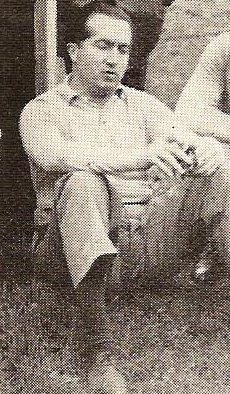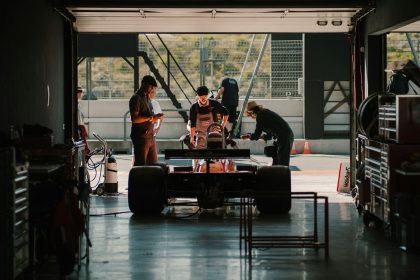If you want to understand the soul of Formula 1, you don’t start with the numbers. You start with the ghosts. And among the most haunting is Alberto Ascari—a man whose life and death were so steeped in ritual, precision, and tragic symmetry that even the most hard-nosed engineer in Maranello might pause before dismissing the idea of fate. On what would have been his 107th birthday, we revisit the story of the first double world champion, the man who made superstition an art form and precision a weapon, and whose end remains one of the sport’s most chilling tales.
The Blue Helmet and the Shadow of Montlhéry
Alberto Ascari was born into racing, but not into comfort. His father, Antonio Ascari, was a titan of the pre-war Grand Prix scene, and his death at Montlhéry in 1925, when Alberto was just seven, cast a shadow that would never quite lift. The younger Ascari inherited not just his father’s talent, but also his anxieties. The number 26, the date of his father’s death, became a specter. So did the age of 36. Ascari’s rituals—his pale blue helmet, his blue overalls, his insistence on entering the car from the same side—were not quirks. They were armor.
His superstition was legendary. He would not race without his lucky gear, and he followed routines with the kind of devotion usually reserved for monks or, perhaps, Ferrari mechanics before a scrutineering session. As Pirelli’s retrospective notes, Destiny was already calling. Pirelli: Ascari and a destiny foretold
The Metronome of Maranello
Ascari’s driving style was the antithesis of the wild, seat-of-the-pants heroics that defined many of his contemporaries. He was not a showman. He was a metronome. His lines were clean, his throttle application smooth, his mechanical sympathy legendary. He was, in the words of one contemporary, the only man who could make a Ferrari look like a Swiss watch.
Between 1952 and 1953, Ascari won nine consecutive Grands Prix—a record that stood for sixty years, until Sebastian Vettel matched it in 2013. He won 13 Grands Prix, took 14 poles, and set 12 fastest laps in a career that spanned just five seasons. He was the first man to win multiple world titles for Ferrari, and the first Italian to do so in Formula 1. Amazing Cars and Drives: Alberto Ascari Biography
His approach to racing was characterised by careful preparation and attention to detail. Alberto Ascari would spend hours studying circuits, understanding car setups, and working with his teams to optimise performance. This professional approach was ahead of its time and helped establish standards that modern drivers still follow.
Amazing Cars and Drives
The Weight of Ritual
Ascari’s superstitions were not just for show. They were a response to the ever-present danger of the era. In the 1950s, racing was a game of Russian roulette played at 250 km/h. Mechanical failures were common, safety standards were minimal, and every race was a negotiation with mortality. Ascari’s rituals were a way to impose order on chaos.
He was known to avoid the number 26, the date of his father’s death. He would not race without his blue helmet and overalls. He entered and exited the car from the same side. He even had a preferred sequence for putting on his gloves and boots. These habits became so ingrained that when he broke them, people noticed—and worried.
Ascari was famously superstitious, a trait that shaped many aspects of his racing life. He had a number of rituals and habits he followed religiously: Blue Helmet and Lucky Gear, Numbers and Dates, Routine.
Internal F1 Historical Database
The Monaco Harbor and the Final Omen
The 1955 Monaco Grand Prix should have been a footnote in Ascari’s career. Instead, it became a prelude to tragedy. On lap 81, Ascari’s Lancia plunged into the harbor after a misjudgment at the chicane. He survived, emerging from the water battered but alive—a miracle in an era when miracles were in short supply.
Four days later, Ascari visited Monza to watch his friend Eugenio Castellotti test a Ferrari sports car. He was not scheduled to drive. He was not wearing his blue helmet or overalls. But, perhaps out of curiosity or restlessness, he decided to take a few laps. He borrowed Castellotti’s white helmet and set off.
On his third lap, at the Vialone curve, Ascari lost control. The car somersaulted, and Ascari was thrown out, dying instantly. The date was May 26, 1955. He was 36 years old—the same age, on the same day of the month, as his father.
The accident was never fully explained. Some speculated that Ascari may have been affected by lingering injuries from his Monaco crash, or that the car had a mechanical failure. The coincidence of the date, his age, and the circumstances eerily echoed the fate of his father, reinforcing the legend of Ascari’s superstition.
Internal F1 Historical Database
The Tragedy of Style
Ascari’s death was more than a personal tragedy. It was a loss of a certain kind of style—a style defined by restraint, discipline, and an almost mathematical approach to risk. In an era that celebrated daredevils, Ascari proved that precision could be just as heroic as bravado.
His legacy is not just in the numbers, though they are impressive enough. It is in the way he approached the sport: as a craft, a science, and, yes, a ritual. He was the first to show that winning in Formula 1 was not just about speed, but about understanding, preparation, and respect for the machinery.
The Numbers Behind the Legend
Let’s not forget the cold, hard facts—because Ascari, for all his superstition, was a man of numbers:
| Statistic | Value |
|---|---|
| Grand Prix Wins | 13 |
| Pole Positions | 14 |
| Fastest Laps | 12 |
| Podiums | 17 |
| World Championships | 2 (1952, 1953) |
| Consecutive Wins | 9 (1952–53) |
He remains the only Italian to win multiple world titles in Formula 1, and his nine-race winning streak stood as a record for six decades. His dominance with Ferrari in the early 1950s set a standard that even the Scuderia has struggled to match since.
The Modern Echo
Why does Ascari’s story still matter in 2025? Because Formula 1, for all its wind tunnels and simulators, remains a sport haunted by the past. Every time a driver dons a lucky charm or follows a ritual, they are paying homage to Ascari. Every time a team obsesses over preparation, they are channeling his spirit.
And every time fate intervenes—be it a freak accident, a mechanical failure, or a miraculous escape—the paddock remembers that, for all our science, there is still room for superstition.
As the Pirelli article so aptly puts it: Destiny was already calling. Pirelli: Ascari and a destiny foretold












